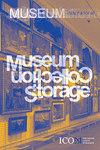The Shared Storage Facility in Poland: A Pilot Project of the National Institute for Museums and Public Collections (NIMOZ)
IF 0.4
4区 艺术学
0 ART
引用次数: 0
Abstract
Abstract The safe storage of collections for future generations is the most important statutory activity of every museum worldwide. Although this objective is a long-held one, statistics show that, regrettably, a historical and global problem still exists in this field, including for Polish museums. Fortunately, positive changes have been implemented since the end of the 20th century, resulting not only in new infrastructure projects, but also in new approaches to the longstanding problem. Contemporary museum storage facilities are perceived not only as restricted museum spaces, but also, and primarily, as a combination of places, people and processes. Storage can therefore represent an optimum tool for museum conservation, when understood as a change management process whose purpose is to exercise conscious and real influence on the durability of collections. Importantly, this process should correspond to contemporary environmental protection practices. Then, and only then, will museums be capable of protecting cultural heritage appropriately, without increasing risks to future generations. In Poland, the National Institute for Museums and Public Collections (NIMOZ) is currently implementing an infrastructure project entitled ‘The Central Storage Facility for Museum Collections’ (CMZM), whose concept encompasses the questions and problems referred to above. In effect, a shared storage facility will be built in the suburbs of Warsaw to provide high-quality protection for collections, while employing cost-efficient construction processes and low-energy solutions while in operation. The pilot project and case study represents a model solution: one that can be followed by museum professionals planning new collection storage facilities in other regions of Poland.波兰的共享存储设施:国家博物馆和公共收藏研究所(NIMOZ)的试点项目
摘要为子孙后代安全储存藏品是世界各地博物馆最重要的法定活动。尽管这一目标由来已久,但统计数据显示,令人遗憾的是,这一领域仍然存在历史和全球问题,包括波兰博物馆。幸运的是,自20世纪末以来,积极的变革已经实施,不仅产生了新的基础设施项目,还产生了解决长期问题的新方法。当代博物馆的存储设施不仅被视为受限制的博物馆空间,而且主要是场所、人员和过程的结合。因此,当被理解为一个变革管理过程时,存储可以代表博物馆保护的最佳工具,其目的是对藏品的耐久性产生有意识和真实的影响。重要的是,这一过程应符合当代的环境保护做法。只有这样,博物馆才能在不增加后代风险的情况下,适当地保护文化遗产。在波兰,国家博物馆和公共收藏研究所(NIMOZ)目前正在实施一个名为“博物馆藏品中央储存设施”的基础设施项目,其概念包括上述问题。实际上,将在华沙郊区建造一个共享存储设施,为藏品提供高质量的保护,同时在运营中采用成本效益高的施工工艺和低能耗解决方案。试点项目和案例研究代表了一种模式解决方案:博物馆专业人员可以效仿该方案,在波兰其他地区规划新的藏品储存设施。
本文章由计算机程序翻译,如有差异,请以英文原文为准。
求助全文
约1分钟内获得全文
求助全文
来源期刊

MUSEUM INTERNATIONAL
ART-
CiteScore
0.60
自引率
0.00%
发文量
0
期刊介绍:
In its new revised form Museum International is a forum for intellectually rigorous discussion of the ethics and practices of museums and heritage organizations. The journal aims to foster dialogue between research in the social sciences and political decision-making in a changing cultural environment. International in scope and cross-disciplinary in approach Museum International brings social-scientific information and methodology to debates around museums and heritage, and offers recommendations on national and international cultural policies.
 求助内容:
求助内容: 应助结果提醒方式:
应助结果提醒方式:


